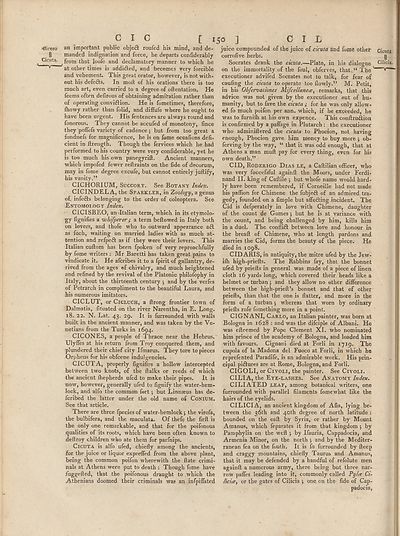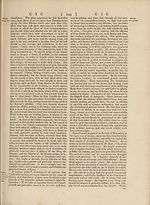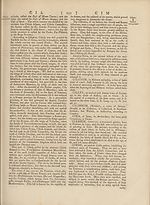Encyclopaedia Britannica, or, a Dictionary of arts, sciences, and miscellaneous literature : enlarged and improved. Illustrated with nearly six hundred engravings > Volume 6, CHI-Crystallization
(160) Page 150
Download files
Complete book:
Individual page:
Thumbnail gallery: Grid view | List view

c I C [ 150 ] C I L
•fticero an important public object roufed his mind, and de¬
ll manded indignation and force, he departs confiderably
Cicuta. from that i00fe an(j declamatory manner to which he
at other times is addided, and becomes very forcible
and vehement. This great orator, however, is not with¬
out his defeds. In mofl of his orations there is too
much art, even carried to a degree of oftentation. He
feems often defirous of obtaining admiration rather than
of operating convidion. He is fometimes, therefore,
fhowy rather than folid, and diffufe where he ought to
have been urgent. His fentences are always round and
fonorous. They cannot be accufed of monotony, fince
they poffefs variety of cadence j but from too great a
fondnefs for magnificence, he is on fome occafions defi¬
cient in ftrength. Though the fervices which he had
performed to his country were very confiderable, yet he
is too much his own panegyrift. Ancient manners,
which impofed fewer reftraints on the fide of decorum,
may in fome degree excufe, but cannot entirely juftify,
his vanity.”
CICHORIUM, Succory. See Botany Index.
CICINDELA, the Sparkler, in Zoology, a genus
of infeds belonging to the order of coleoptera. See
Entomology Index.
C1CISBEO, an-Italian term, which in its etymolo¬
gy fignifies a whifperer; a term bellowed in Italy both
on lovers, and thofe who to outward appearance ad
as fuch, waiting on married ladies with as much at¬
tention and refped as if they were their lovers. This
Italian cuflom has been fpoken of very reproachfully
by fome writers : Mr Baretti has taken great pains to
vindicate it. He afcribes it to a fpirit of gallantry, de¬
rived from the ages of chivalry, and much heightened
and refined by the revival of the Platonic philofophy in
Italy, about the thirteenth century j and by the verfes
of Petrarch in compliment to the beautiful Laura, and
his numerous imitators.
CICLUT, or Cicluch, a ftrong frontier town of
Dalmatia, fituated on the river Narentha, in E. Long.
18. 22. N. Lat. 43. 29. It is furrounded with walls
built in the ancient manner, and was taken by the Ve¬
netians from the Turks in 1694.
CICONES, a people of Thrace near the Hebrus.
Ulyffes at his return from Troy conquered them, and
plundered their chief city Ifmarus. They tore to pieces
Orpheus for his obfcene indulgencies.
CICUTA, properly fignifies a hollow intercepted
between two knots, of the flalks or reeds of which
the ancient fhepherds ufed to make their pipes. It is
now, however, generally ufed to fignify the water-hem¬
lock, and alfo the common fort; but Linnaeus has de-
fcribed the latter under the old name of Conium.
See that article.
There are three fpecies of water-hemlock ; the virofa,
the bulbifera, and the maculata. Of thefe the firft is
the only one remarkable, and that for the poifonous
qualities of its roots, which have been often known to
deflroy children who ate them for parfnips.
Cicuta is alfo ufed, chiefly among the ancients,
for the juice or liquor expreffed from the above plant,
being the common poifon wherewith the ftate crimi¬
nals at Athens were put to death : Though fome have
fuggefted, that the poifonous draught to which the
Athenians doomed their criminals was an infpiffated
juice compounded of the juice of cicuta and fome other Cicuta
corrofive herbs. ||
Socrates drank the cicuta.—Plato, in his dialogue Cilicia,
on the immortality of the foul, obferves, thatThe
executioner advifed Socrates not to talk, for fear of
caufing the cicuta to operate too flowly.” M. Petit,
in his Obfervaiiones Mifcellctnece, remarks, that this
advice was not given by the executioner out of hu¬
manity, but to fave the cicuta ; for he was only allow¬
ed fo much poifon per ann. which, if he exceeded, he
was to furnilh at his own expence. This conftruilion
is confirmed by a paffage in Plutarch : the executioner
who adminiftered the cicuta to Phocion, not having
enough, Phocion gave him money to buy more j ob-
ferving by the way, “ that it was odd enough, that at
Athens a man muft pay for every thing, even for his
own death.”
CID, Roderigo Dias le, a Caftilian officer, who
was very fuccefsful againft the Moors, under Ferdi¬
nand II. king of Caftile j but whofe name would hard¬
ly have been remembered, if Corneille had not made
his paflion for Chimene the fubjedt of an admired tra¬
gedy, founded on a Ample but affedting incident. The
Cid is defperately in love with Chimene, daughter
of the count de Gomes j but he is at variance with
the count, and being challenged by him, kills him
in a duel. The conflidt between love and honour in
the breaft of Chimene, who at length pardons and
marries the Cid, forms the beauty of the piece. He
died in 1098.
CID ARIS, in antiquity, the mitre ufed by the Jew-
ifh high-priefts. The Rabbins fay, that the bonnet
ufed by priefts in general was made of a piece of linen
cloth 16 yards long, which covered their heads like a
helmet or turban 5 and they allow no other difference
between the high-prieft’s bonnet and that of other
priefts, than that the one is flatter, and more in the
form of a turban j whereas that worn by ordinary
priefts rofe fomething more in a point.
CIGNANI, Carlo, an Italian painter, was born at
Bologna in 1628 : and was the difciple of Albani. He
was efteemed by Pope Clement XL who nominated
him prince of the academy of Bologna, and loaded him
with favours. Cignani died at Forli in 1719. The
cupola of la Madona del Fuoco at Forli, in which he
reprefented Paradife, is an admirable work. His prin¬
cipal pi£tures are at Rome, Bologna, and Forli.
CIGOLI, or Civoli, the painter. See Civoli.
CILIA, the Eye-lashes. See Anatomy Index.
CILIATED LEAE, among botanical writers, one
furrounded with parallel filaments fomewhat like the
hairs of the eyelids.
CILICIA, an ancient kingdom of Afia, lying be¬
tween the 36th and 40th degree of north latitude :
bounded on the eaft by Syria, or rather by Mount
Amanus, which feparates it from that kingdom ; by
Pamphylia on the weft j by Ifauria, Cappadocia, and
Armenia Minor, on the north $ and by the Mediter¬
ranean fea on the fouth. It is fo furrounded by fteep
and craggy mountains, chiefly Taurus and Amanus,
that it may be defended by a handful of refolute men
againft a numerous army, there being but three nar¬
row pafies leading into it, commonly called Pylft Ci-
liciee, or the gates of Cilicia ; one on the fide of Cap¬
padocia,
•fticero an important public object roufed his mind, and de¬
ll manded indignation and force, he departs confiderably
Cicuta. from that i00fe an(j declamatory manner to which he
at other times is addided, and becomes very forcible
and vehement. This great orator, however, is not with¬
out his defeds. In mofl of his orations there is too
much art, even carried to a degree of oftentation. He
feems often defirous of obtaining admiration rather than
of operating convidion. He is fometimes, therefore,
fhowy rather than folid, and diffufe where he ought to
have been urgent. His fentences are always round and
fonorous. They cannot be accufed of monotony, fince
they poffefs variety of cadence j but from too great a
fondnefs for magnificence, he is on fome occafions defi¬
cient in ftrength. Though the fervices which he had
performed to his country were very confiderable, yet he
is too much his own panegyrift. Ancient manners,
which impofed fewer reftraints on the fide of decorum,
may in fome degree excufe, but cannot entirely juftify,
his vanity.”
CICHORIUM, Succory. See Botany Index.
CICINDELA, the Sparkler, in Zoology, a genus
of infeds belonging to the order of coleoptera. See
Entomology Index.
C1CISBEO, an-Italian term, which in its etymolo¬
gy fignifies a whifperer; a term bellowed in Italy both
on lovers, and thofe who to outward appearance ad
as fuch, waiting on married ladies with as much at¬
tention and refped as if they were their lovers. This
Italian cuflom has been fpoken of very reproachfully
by fome writers : Mr Baretti has taken great pains to
vindicate it. He afcribes it to a fpirit of gallantry, de¬
rived from the ages of chivalry, and much heightened
and refined by the revival of the Platonic philofophy in
Italy, about the thirteenth century j and by the verfes
of Petrarch in compliment to the beautiful Laura, and
his numerous imitators.
CICLUT, or Cicluch, a ftrong frontier town of
Dalmatia, fituated on the river Narentha, in E. Long.
18. 22. N. Lat. 43. 29. It is furrounded with walls
built in the ancient manner, and was taken by the Ve¬
netians from the Turks in 1694.
CICONES, a people of Thrace near the Hebrus.
Ulyffes at his return from Troy conquered them, and
plundered their chief city Ifmarus. They tore to pieces
Orpheus for his obfcene indulgencies.
CICUTA, properly fignifies a hollow intercepted
between two knots, of the flalks or reeds of which
the ancient fhepherds ufed to make their pipes. It is
now, however, generally ufed to fignify the water-hem¬
lock, and alfo the common fort; but Linnaeus has de-
fcribed the latter under the old name of Conium.
See that article.
There are three fpecies of water-hemlock ; the virofa,
the bulbifera, and the maculata. Of thefe the firft is
the only one remarkable, and that for the poifonous
qualities of its roots, which have been often known to
deflroy children who ate them for parfnips.
Cicuta is alfo ufed, chiefly among the ancients,
for the juice or liquor expreffed from the above plant,
being the common poifon wherewith the ftate crimi¬
nals at Athens were put to death : Though fome have
fuggefted, that the poifonous draught to which the
Athenians doomed their criminals was an infpiffated
juice compounded of the juice of cicuta and fome other Cicuta
corrofive herbs. ||
Socrates drank the cicuta.—Plato, in his dialogue Cilicia,
on the immortality of the foul, obferves, thatThe
executioner advifed Socrates not to talk, for fear of
caufing the cicuta to operate too flowly.” M. Petit,
in his Obfervaiiones Mifcellctnece, remarks, that this
advice was not given by the executioner out of hu¬
manity, but to fave the cicuta ; for he was only allow¬
ed fo much poifon per ann. which, if he exceeded, he
was to furnilh at his own expence. This conftruilion
is confirmed by a paffage in Plutarch : the executioner
who adminiftered the cicuta to Phocion, not having
enough, Phocion gave him money to buy more j ob-
ferving by the way, “ that it was odd enough, that at
Athens a man muft pay for every thing, even for his
own death.”
CID, Roderigo Dias le, a Caftilian officer, who
was very fuccefsful againft the Moors, under Ferdi¬
nand II. king of Caftile j but whofe name would hard¬
ly have been remembered, if Corneille had not made
his paflion for Chimene the fubjedt of an admired tra¬
gedy, founded on a Ample but affedting incident. The
Cid is defperately in love with Chimene, daughter
of the count de Gomes j but he is at variance with
the count, and being challenged by him, kills him
in a duel. The conflidt between love and honour in
the breaft of Chimene, who at length pardons and
marries the Cid, forms the beauty of the piece. He
died in 1098.
CID ARIS, in antiquity, the mitre ufed by the Jew-
ifh high-priefts. The Rabbins fay, that the bonnet
ufed by priefts in general was made of a piece of linen
cloth 16 yards long, which covered their heads like a
helmet or turban 5 and they allow no other difference
between the high-prieft’s bonnet and that of other
priefts, than that the one is flatter, and more in the
form of a turban j whereas that worn by ordinary
priefts rofe fomething more in a point.
CIGNANI, Carlo, an Italian painter, was born at
Bologna in 1628 : and was the difciple of Albani. He
was efteemed by Pope Clement XL who nominated
him prince of the academy of Bologna, and loaded him
with favours. Cignani died at Forli in 1719. The
cupola of la Madona del Fuoco at Forli, in which he
reprefented Paradife, is an admirable work. His prin¬
cipal pi£tures are at Rome, Bologna, and Forli.
CIGOLI, or Civoli, the painter. See Civoli.
CILIA, the Eye-lashes. See Anatomy Index.
CILIATED LEAE, among botanical writers, one
furrounded with parallel filaments fomewhat like the
hairs of the eyelids.
CILICIA, an ancient kingdom of Afia, lying be¬
tween the 36th and 40th degree of north latitude :
bounded on the eaft by Syria, or rather by Mount
Amanus, which feparates it from that kingdom ; by
Pamphylia on the weft j by Ifauria, Cappadocia, and
Armenia Minor, on the north $ and by the Mediter¬
ranean fea on the fouth. It is fo furrounded by fteep
and craggy mountains, chiefly Taurus and Amanus,
that it may be defended by a handful of refolute men
againft a numerous army, there being but three nar¬
row pafies leading into it, commonly called Pylft Ci-
liciee, or the gates of Cilicia ; one on the fide of Cap¬
padocia,
Set display mode to:
![]() Universal Viewer |
Universal Viewer | ![]() Mirador |
Large image | Transcription
Mirador |
Large image | Transcription
Images and transcriptions on this page, including medium image downloads, may be used under the Creative Commons Attribution 4.0 International Licence unless otherwise stated. ![]()
| Permanent URL | https://digital.nls.uk/193009503 |
|---|
| Attribution and copyright: |
|
|---|
| Description | Ten editions of 'Encyclopaedia Britannica', issued from 1768-1903, in 231 volumes. Originally issued in 100 weekly parts (3 volumes) between 1768 and 1771 by publishers: Colin Macfarquhar and Andrew Bell (Edinburgh); editor: William Smellie: engraver: Andrew Bell. Expanded editions in the 19th century featured more volumes and contributions from leading experts in their fields. Managed and published in Edinburgh up to the 9th edition (25 volumes, from 1875-1889); the 10th edition (1902-1903) re-issued the 9th edition, with 11 supplementary volumes. |
|---|---|
| Additional NLS resources: |
|

